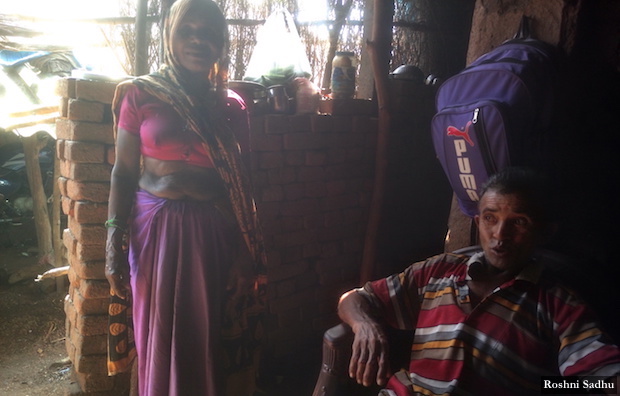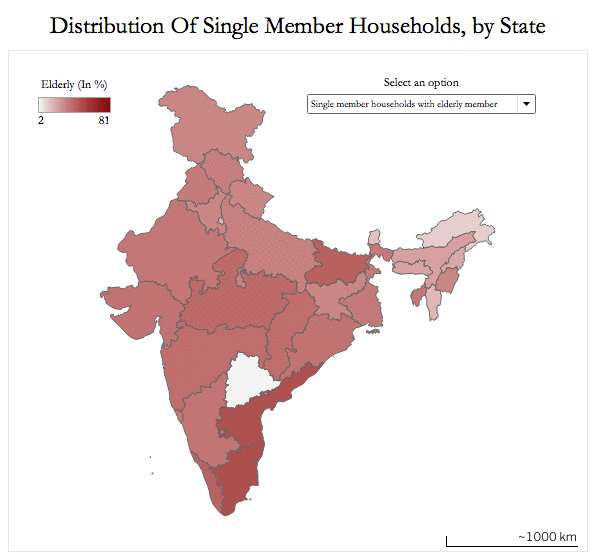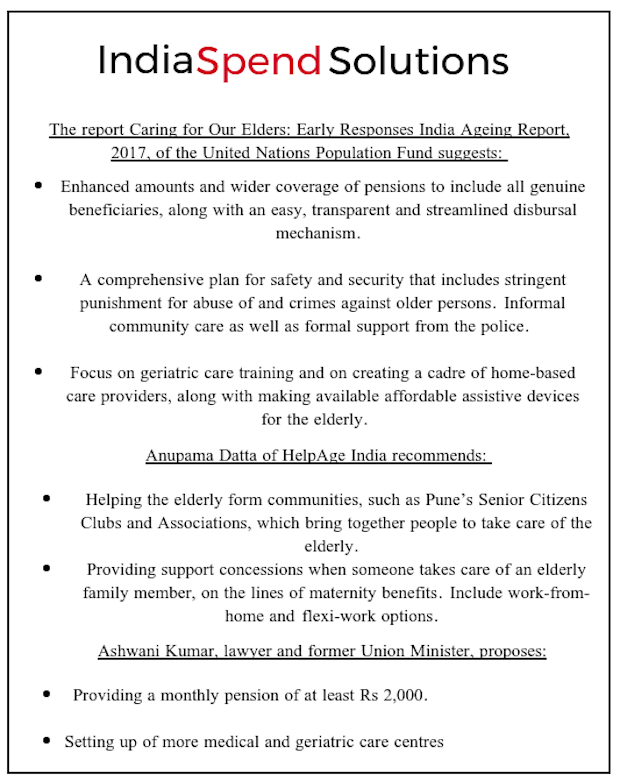60+ Is India's Fastest Growing Demographic. Yet, Public Policy Largely Ignores The Elderly

Kisturi Devi, 62, lives with her two daughters-in-law and nine grandchildren in Ballana village of Alwar district in Rajasthan. All three women are widowed. Since 2013, Devi has been receiving an old-age pension of Rs 500 per month--half the amount that would qualify her as living below the poverty line of Rs 32 per day in rural India...
Nearly 1 in 10 Indians is over 60 years old, a fact often lost amid the economic bombast of India's 'demographic dividend'.
Devi is among India's 100 million elderly people, numerous enough to form one of the 15 most populous countries in the world. This number is set to grow at the fastest pace among all demographic groups--while India's overall population is likely to grow by 55% between 2000 and 2050, the corresponding figures for the 60+ and 80+ age groups are 326% and 700%.
Yet, as Devi's case makes clear, the majority of India's aged subsist on meagre support from the government. The family continues to be seen as the 'normal' site for the care of the elderly, even as factors such as decreasing family size, migration of the young for work and abuse within the family make this a less than ideal situation.


Left: Kisturi Devi (centre) with three of her grandchildren and a Panchayat Extension Officer; Right: the shanty where she lives.
Many elderly people live alone--the majority of them women--and are easy targets of crime. Residential homes are not yet a viable alternative. Only the economically privileged can afford private homes, and government ones are few and far between.
This has important implications for public policy as ageing does not just affect the elderly, it affects everyone in society.
The elderly, in numbers
Roughly 9% of India's population is aged 60 years or more, as per Census figures from 2011, as opposed to 12% globally. By 2050, the 60+ age group is expected to form 19% of India's population.
Kerala, Goa, Tamil Nadu, Punjab and Haryana are the top five states where the elderly comprise 10% or more of the total population, while the north-eastern states of Arunachal Pradesh, Meghalaya, Nagaland, Mizoram and Assam have the smallest proportion of people aged 60 years or more.
Caring for the elderly is a Directive Principle of State Policy under Article 41 of the Constitution, which states: "The State shall, within the limits of its economic capacity and development, make effective provision for securing the right to work, to education and to public assistance in cases of unemployment, old age, sickness and disablement, and in other cases of undeserved want."
Meagre financial support
In Khanpatla village of Panchmahal district of of Gujarat, Ranchhodbhai, 65, and his wife Gangaben, 63, have been enrolled as beneficiaries under the state government's old-age pension scheme since the last two years. This entitles them to Rs 400 each per month, but they said they have not received a pension for nearly nine months. This delay is not new, they said, and in any case it hardly covers their bare minimum survival needs.

Gangaben and Ranchhodbhai at their home in Khanpatla, Panchmahal, Gujarat.
The Indian government has been providing social pensions under the National Social Assistance Programme since 1995. In 2007, the programme was reintroduced as the Indira Gandhi National Old Age Pension Scheme (IGNOAPS) for elderly people who belong to a below-poverty-line household. The central government contributes Rs 200 per month towards pension for each person aged 60 years or above and Rs 500 per month for everyone aged 80 years and above. State governments are expected to supplement this with at least a matching sum.
The draft National Policy for Senior Citizens of 2011 recommended an amount of Rs 1,000 as monthly pension under IGNOAPS. Although the policy has not yet been finalised, some states have increased their contribution to comply with this recommendation. By and large, pensions in most states remain meagre, varying from Rs 200 in Assam and Nagaland to Rs 250 in Mizoram, Rs 400 in Bihar and Gujarat, and Rs 500 in Rajasthan and Punjab. Consequently, lakhs of elderly citizens live in penury.
| Old Age Pension Amounts, By State | |
|---|---|
| State | Monthly Pension (In Rs) |
| Andhra Pradesh | 1000 |
| Assam | 200 (60 - 79 years) |
| 500 (80+) | |
| Bihar | 400 / 500 (80+) |
| Chandigarh | 1000 |
| Delhi | 2000 (60 to 69) |
| 2500 (70 and above + 60 - 69 belonging to SC / ST/ Minorities) | |
| Goa | 2000 |
| Gujarat | 400 |
| 800 (80 + ) | |
| Haryana | 1600 |
| Himachal Pradesh | 650 (60 to 79 years) |
| 1200 (above 80 years) | |
| India (Central) | 200 |
| 500 (80+) | |
| Jammu & Kashmir | 1000 |
| Jharkhand | 600 |
| 700 (80 + ) | |
| Karnataka | 500 (for those between 60 and 64) |
| Kerala | 1100 (minimum amount) |
| Maharashtra | 600 |
| Mizoram | 250 (60 - 79 years) |
| 550 (80 + ) | |
| Nagaland | 200 (60 - 79 years) |
| 500 (80 + ) | |
| Odisha | 300 |
| 500 (80 + ) | |
| Punjab | 500 |
| Rajasthan | 500 |
| Tamil Nadu | 1000 |
| Telangana | 1000 |
| Uttar Pradesh | 300 |
| 500 (80 + ) | |
| West Bengal | 1000 |
Source: Andhra Pradesh, Assam, Bihar, Chandigarh, Delhi, Goa, Gujarat, Haryana, Himachal Pradesh, Jammu and Kashmir, Jharkhand, Karnataka, Kerala, Maharashtra, Mizoram, Nagaland, Odisha, Punjab, Rajasthan, Tamil Nadu, Telangana, Uttar Pradesh, West Bengal (to the elderly of the Scheduled Tribe communities)
An ongoing public interest litigation (PIL) in the Supreme Court demands a basic old-age pension of Rs 2,000 per month. "This 200 rupees was fixed years ago and it has no relevance to the cost of living today," Ashwani Kumar, former Union Minister of Law and Justice, who has filed the PIL, told IndiaSpend. "The idea is to give to the elderly a minimum amount of financial help that can ensure to themselves in the autumn of their lives, a life of dignity and well being."
In a survey by the socio-economic advocacy group Centre for Equity Studies, pension beneficiaries said amounts of Rs 1,600 to Rs 2,000 were "adequate". A study published in the HelpAge India-Research & Development Journal in 2013 had calculated that providing a pension of Rs 2,000 to 90% of India's elderly would cost 1.81% of the GDP; a pension of Rs 1,000 would cost less than 1% of the GDP. (The other 10% of the elderly are presumed to have job-related pensions or to be otherwise well off.)
As per the National Social Assistance Programme website, millions of the elderly receive old-age pension. This makes them an attractive vote-bank during elections, when the pension amount becomes an important issue and finds mention in several election manifestos (such as here, here and here). Yet, despite successive elections, this wooing of the elderly voter has not translated into a dignified pension amount in a majority of Indian states.
Pensions, services difficult to access
Not only are pensions small, the elderly also have to contend with ambiguous processes and unhelpful and rude staff. "My life as a citizen gets affected by the lowest level in the hierarchy I deal with," Anupama Datta, director of Policy Research and Development at the non-profit HelpAge India, told IndiaSpend, adding that often sympathetic and well-meaning senior officials are unable to infuse the same attitude lower down in the system.
The residents of Gharaunda, an old-age home in Fatehpur Beri, Delhi, shared with IndiaSpend the many challenges they face when applying for a pension. Renuka, 71, who goes by her first name only, hails from Bihar. She wanted to enrol for the Delhi government's old-age pension after she moved into Gharaunda but did not have local residential proof since all her earlier documents were from her native state. When she visited a government office to apply for local identity documents, she was turned away saying she did not need an identity proof "at her age".
Lack of empathy and support is evident in other ways too. Neelam Mohan, chairperson and founder-trustee of Panchvati, a private old-age home in Delhi's Tughlakabad, told IndiaSpend about her ongoing and thus-far futile struggle to get the entry road to their home cleared because ambulances and water tankers could not come in.
"In our general psyche, subconsciously, the elderly are not seen as part of the productive population so governments--I am not saying they are wilfully doing it--are often not mindful of their concerns," Datta of HelpAge India told IndiaSpend. "Further, elderly are still considered a family responsibility. This kind of thinking affects our policy making and policy intervention."
More elderly living alone
The murder of an elderly couple who were living by themselves in Delhi's Ashok Vihar in early September 2017 was widely reported. The suspect was a male nurse they had hired and who fled when the incident came to light.
A few months ago, a 22-year-old man had been convicted by a local court for the rape and murder of an 81-year-old widow who lived alone. The man had been engaged by the victim for full-time care.
Crimes against the elderly warrant special attention, and the National Crime Records Bureau has started including a separate chapter on 'Crime against Senior Citizens' in its annual publication on Crime in India since 2014. The number of crimes has risen by 9.7% in just the two years for which data are available--18,714 cases were reported under the Indian Penal Code in 2014, which increased to 20,532 in 2015.
Maharashtra reported the highest incidence of crime--in absolute numbers--followed by Madhya Pradesh, Andhra Pradesh and Tamil Nadu. Mapping the data reveals a higher incidence of crime against the elderly in the southern parts of the country.
Delhi, Madhya Pradesh, Chhattisgarh and Andhra Pradesh, meanwhile, reported the highest rate of crime--arrived at by dividing the incidence of crime by 100,000 population over a given period, a more meaningful metric.
Old age makes one an easier crime target, particularly if one lives alone. According to Census 2011, 4% of India's 240 million households consist of a single person. In half of these (48%), the person is aged 60 years or more. In Tamil Nadu and Andhra Pradesh, this figure is as high as 63% and 62%, respectively.

Source: Census 2011
Further, 73% of these single, elderly persons are women. In the southern states of Karnataka and Andhra Pradesh and the union territory of Puducherry, roughly 81% of elderly, one-person households consist of women.
Living with family may not, however, necessarily be the solution, even though families have traditionally been expected to care for their elderly. Half the respondents surveyed by HelpAge India for its report on Elderly Abuse in 2014 reported having faced some form of abuse. The figure had nearly doubled from 23% respondents reporting abuse in the previous year's survey. Most of those abused lived with their families, and the daughter-in-law and son emerged as the most likely to inflict abuse.
"Even in a progressive state like Punjab where there has been a very strong tradition of joint families where children look after their parents, I noticed a huge neglect of the elderly," Kumar said. "They were vulnerable in their own families and economically dependent on their children... I came across many people who wanted to stay away from their children, particularly their sons and daughters-in-law and I realised it was a serious humanitarian issue."
If families turn abusive, or when the aged have no children to look after them, many of them have no way out, especially when poor health leaves them unable to take care of themselves and when safety is a concern.
Residential homes
Residential homes for the elderly are one option. The Draft National Policy of 2011 recommends setting up "homes with assisted living facilities for abandoned senior citizens" in every district and providing adequate budgetary support for the same.
An IndiaSpend analysis of the latest data on the Ministry of Social Justice's website shows that the 500-odd projects (old-age homes/day care centres/respite care homes only) supported by the ministry were concentrated in 215 of India's 700-plus districts. Several of these were marked as "Discontinued" or "Blacklisted".
In the four financial years from 2012-13 to 2015-16, the central government released a little over Rs 47 crore to all states to support old-age homes. In some years, this amounted to Rs 400,000 per home, or Rs 33,000 a month, for homes that would cater to lodging, food and other facilities for numerous residents.
Source: Lok Sabha responses here and here
Our analysis shows that half of these funds went to just the four states of Andhra Pradesh, Telangana, Tamil Nadu and Karnataka, which together have just over a fifth (21%) of the 60+ population of the country. States with the largest elderly population, Uttar Pradesh (15%) and Maharashtra (11%), received 3% and 6%, respectively.
What's worse, Kumar said, is that this money is not even utilised: "The reason given is that requests come from state governments towards the end of the financial year and they can't be processed, and the funds lapse--how apathetic can one be?"
Private homes, meanwhile, are beyond the reach of most.
Policy blind spot
The few times the Lok Sabha (the lower house of parliament) has addressed the elderly question, the discussion has been restricted to three or four talking points--mostly an overview of IGNOAPS and the Integrated Programme for the Older Persons, under which grants are given for the running and maintenance of old-age homes, day-care centres, etc., and the funds released for these.
There has been "not a single debate", Datta said, just "standard answers… And if you're happy with standard answers that means you are just doing a formality--it does not move you."
Any change would have to begin with recognising the severity of the problem, and finding policy solutions.
Various experts IndiaSpend spoke to highlighted the need for a decent and realistic pension to enable the elderly to live on their own terms.
While there is need for more formal and institutional care, in a country with the scale and social norms of India, formal, institutional care cannot be the norm, Datta said. "Even in the west where the numbers are so small and the budgets are so big, they are also finding it unsustainable and there is this movement of ageing in place," she explained. "And with our kind of numbers, our kind of systems, formal care can take in the burden only of the very few. Basically we'll have to find ways of informal care."
Informal community-based care, where communities of elderly people watch out for each other, even hire helpers through pooled resources, have been successful in places such as Pune.
The wider community and law enforcement agencies must look out for the safety of elderly citizens, the latest Caring for Our Elders: Early Responses India Ageing Report report of the United Nations Population Fund suggests. It adds that India needs to create a cadre of home-based care providers, and make affordable assistive devices for the elderly widely available.
Family members who look after aged persons must be given concessions on the lines of maternity benefits, including work-from-home and flexi-work options, Datta of HelpAge India added.

(Chawla is an IndiaSpend-ICFJ Associate. With field inputs from Alok Arunam in Alwar, Rajasthan, and Roshni Sadhu in Panchmahal, Gujarat.)
We welcome feedback. Please write to respond@indiaspend.org. We reserve the right to edit responses for language and grammar.
______________________"Liked this story? Indiaspend.org is a non-profit, and we depend on readers like you to drive our public-interest journalism efforts. Donate Rs 500; Rs 1,000, Rs 2,000."


